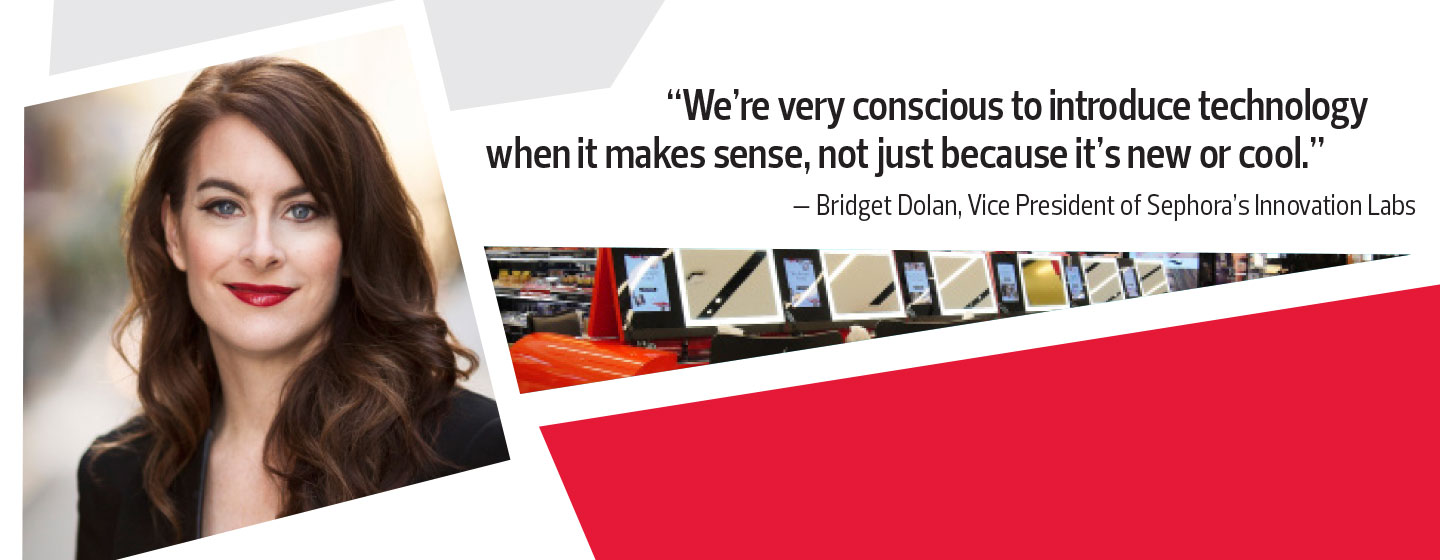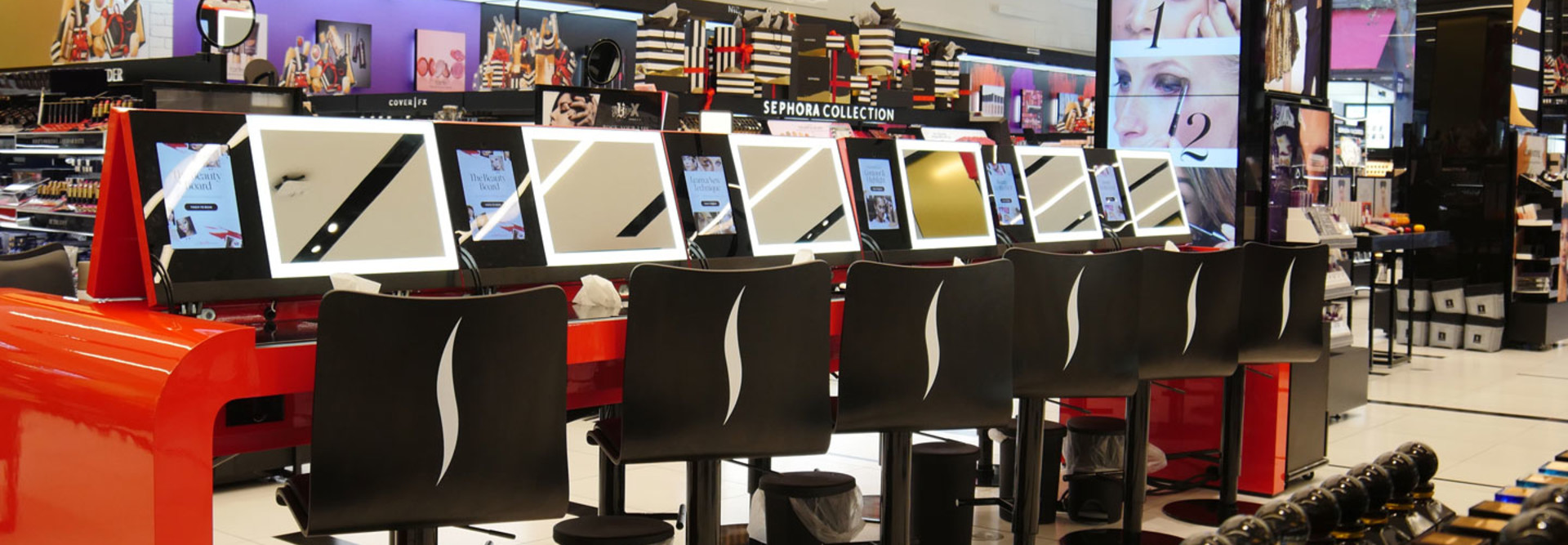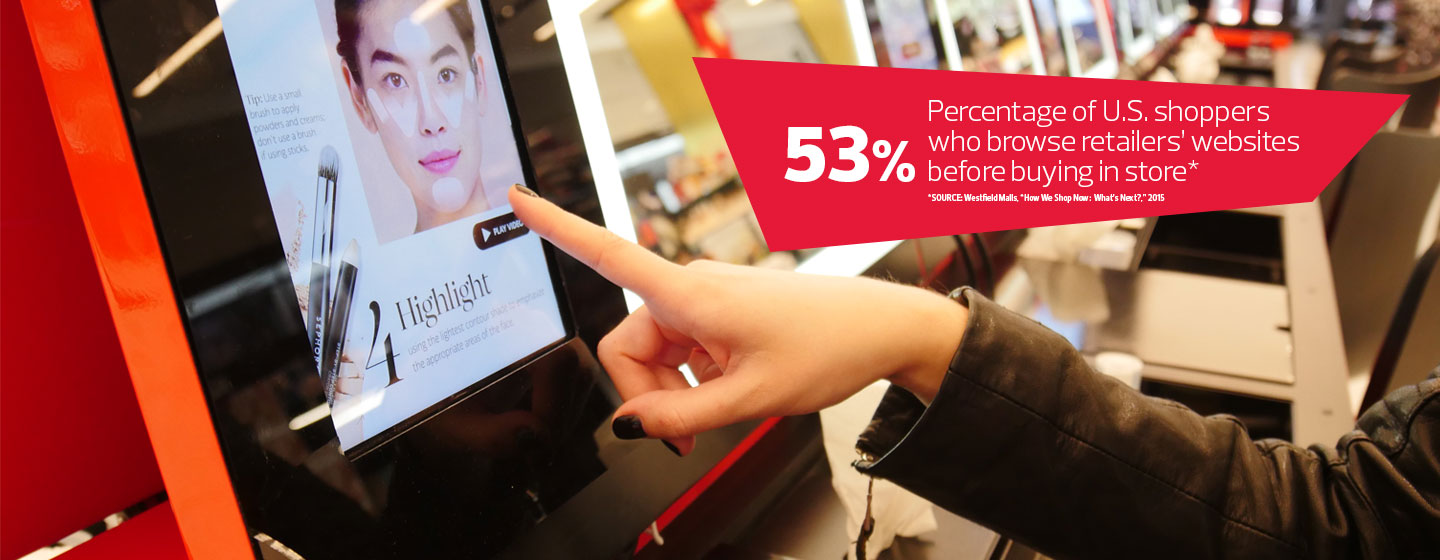Sephora, Neiman Marcus Turn to In-Store Technology to Enhance the Retail Experience
I’m inside Sephora in the heart of downtown San Francisco, and I’m utterly clueless. Outside, hundreds of tourists line up to ride the Powell Street cable cars; inside, the store buzzes with activity.
I’m in the market for a new scent, but I’m too embarrassed to ask a clerk. So I walk over to the Fragrance IQ kiosk near the perfume aisle and answer a series of questions by tapping on the touch screen.
Am I buying this for myself or as a gift? (Myself.) Am I looking for masculine or feminine? (Masculine.) Which types of fragrances do I prefer: Floral or fresh? Warm and spicy? Earthy and woody? I can’t decide, so I tap on each option in turn; in a few moments, a representative scent gently wafts out from a small “InstaScent” nozzle above a sign saying “Smell Here.”
Turns out I’m warm and spicy. I tap through a few more screens to determine how bold my new scent should be and how I want it to make me feel (sexy, fun, relaxed, chic), then enter my email address. When I’ve finished, the kiosk displays 10 suggestions on screen and then emails them to me.
I’ve just had my first in-store digital shopping experience, but it won’t be my last. Let’s take a look at how retail is rethinking the integration of tech for in-store use by customers.
Testing New In-Store Technologies
Shoppers have come to expect clerks roaming the aisles with Apple iPad devices or other tablets — ready to check stock or let users complete purchases. Price-checking kiosks are common too. But the line between digital and physical shopping is rapidly blurring, as technology transforms retail stores that aim to combine the best of hands-on shopping with the speed and efficiency of the web.
The tech-savvy Sephora has been giving its stores a digital makeover over the past few years, and the Fragrance IQ station is just one of the high-end cosmetics retailer’s enhancements.

“Our Innovation Lab is constantly testing and perfecting new technology we think will be relevant for our clients,” says Bridget Dolan, vice president of the chain’s San Francisco-based lab.
In the center of the Powell Street store, a dozen shoppers sit at a digital workstation, known as The Beauty Workshop, where they can take a group beauty class from an instructor or learn by watching video tutorials on nails, hair and makeup techniques. A service called Color IQ features a touch-screen kiosk that helps Sephora customers winnow thousands of shades to find the right foundation, concealer and lipstick for their skin tones.
At another kiosk, a service called Skincare IQ matches customers with the right treatments for puffy eyes or dry lips.
Over time, Sephora has been gradually rolling out these technologies, Dolan says. For example, Skincare IQ, which debuted in 2012, is available in all of Sephora’s more than 300 stand-alone stores in North America; the relatively new InstaScent device is available only in San Francisco and Boston.
Blending Tech with Shoppers' Habits
In Sephora’s Innovation Lab, the company is busy cooking up even more in-store tech ideas — such as Virtual Artist, an augmented reality app that uses a tablet or smartphone webcam to capture a shopper’s face in real time, then “apply” a shopper’s choice of more than 3,000 lipstick shades. A version of Virtual Artist is available on the web and the Sephora To Go smartphone app.
“We want to innovate how a woman shops with integrated solutions that help her find the right products, but we’re very conscious to introduce technology when it makes sense, not just because it’s new or cool,” Dolan says. “It has to in some way make our clients’ beauty shopping experience better, faster, more intuitive and more fun.”
‘Does This Algorithm Make Me Look Fat?’
Like shopping for cosmetics, finding the right apparel means answering a constant series of questions. Which is better, the red dress or the blue one? Which cut is more flattering? What does this style really look like from behind?
In most stores, shoppers must rely on their memory (or an honest sales associate). Now, Neiman Marcus has mirrors that do the remembering.
The Memory Mirror, developed by Palo Alto, Calif.-based MemoMi Labs and available in 20 locations nationwide, combines a full-length dressing room mirror with a 70-inch LCD, an HD camera and a powerful computer. The cameras record eight-second videos (long enough for a full 360-degree twirl) that shoppers can play back on the mirrors to see how they look or compare outfits side by side.
After logging in using email addresses and personal ID numbers, shoppers can email or text video links — to, say, get a friend’s opinion before laying down the plastic — or post them to Facebook.
The camera sits above the screen at an angle, and the images it captures are distorted, “like a funhouse mirror,” says Scott Emmons, head of the retailer’s Innovation Lab. The secret sauce behind Memory Mirrors is an algorithm that adjusts images to reflect how people actually look, he says. (To answer the question every shopper will be dying to ask: Yes, it’s possible for the algorithm to make someone look thinner, but Neiman Marcus doesn’t do that, he says.)
The technology has the ability to let customers see the same garments in different colors, but the high-end chain hasn’t implemented that yet, says Emmons, in part because of the difficulty of making sure each store has all those different colors in stock. Right now, the mirrors are only in the women’s apparel fitting rooms, but he says the retailer is exploring expanding them to other departments.
“We’re trying to give our customers the best possible view of how items look on them, and allow them to get affirmation from others who couldn’t be with them,” Emmons says. “We want them to leave the store with confidence that they bought the right things.”
Getting a Better Picture with Augmented Reality
If augmented reality (AR) is a good way to virtually try on makeup and clothes, it’s an even better way to avoid costly missteps during home improvement projects. That’s why Lowe’s, the $59 billion hardware giant, is experimenting with Microsoft’s HoloLens AR glasses to let customers see how newly remodeled kitchens will look before they tear out a single cabinet.
Using a Microsoft Surface tablet, shoppers can pick new cabinets, counters, appliances and other kitchen accoutrements, then don the HoloLens to see how their choices would look inside a real kitchen. Unlike virtual reality headsets, which seal viewers off from the world around them, the augmented reality HoloLens overlays virtual objects on top of actual ones, so the wearer can see both real and computer-generated images simultaneously.
Customers can then change from tile to granite counters or swap in stainless steel appliances with just a few taps, says Kyle Nel, vice president of disruptive innovation and executive director of Lowe’s Innovation Labs.
“Not being able to fully visualize a home improvement project can hinder someone from starting or completing it,” Nel explains. “We are always looking for innovative solutions that transform the customer experience and give our customers the confidence and tools they need to design, visualize and bring their projects to life successfully.”
Currently, HoloLens is a pilot project in two Lowe’s Home Improvement centers, one in Raleigh, N.C., and the other in Seattle. “We do not have immediate plans to roll it out to other stores but look to receive valuable feedback from our customers in those locations before planning next steps,” Nel says.
Go Digital or Go Home
According to the National Retail Foundation, e-commerce still accounts for only 7.5 percent of overall sales, but it’s growing at two to three times the rate of brick-and-mortar sales. Surveys by analytics firm RetailNext reveal that foot traffic declined nearly 10 percent in 2015. The writing is on the wall, and it’s in pixels not paint. Retailers such as Sephora, Neiman Marcus and Lowe’s know they need to make the in-store experience as dynamic as possible.
“Retail is a quickly evolving space, and you can either be a part of it or watch it pass you by,” Dolan says. “At Sephora, we choose to lead and be on the forefront of the trends shaping the industry.”










